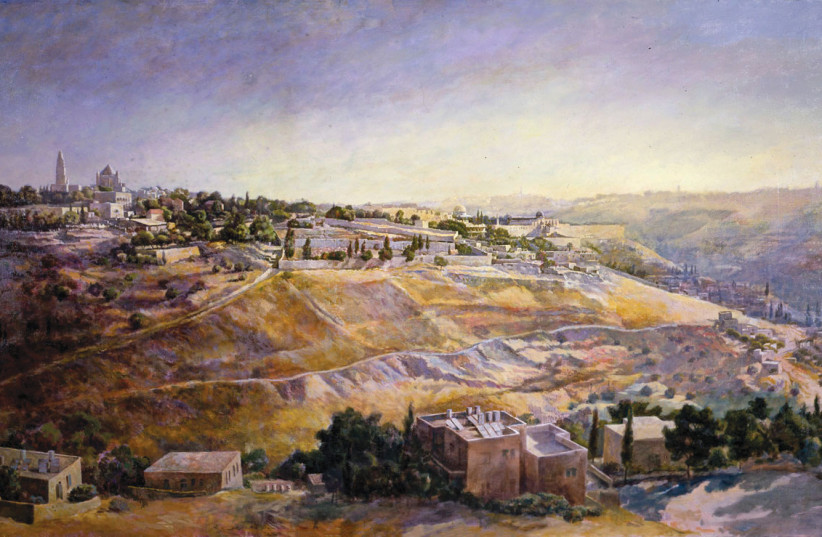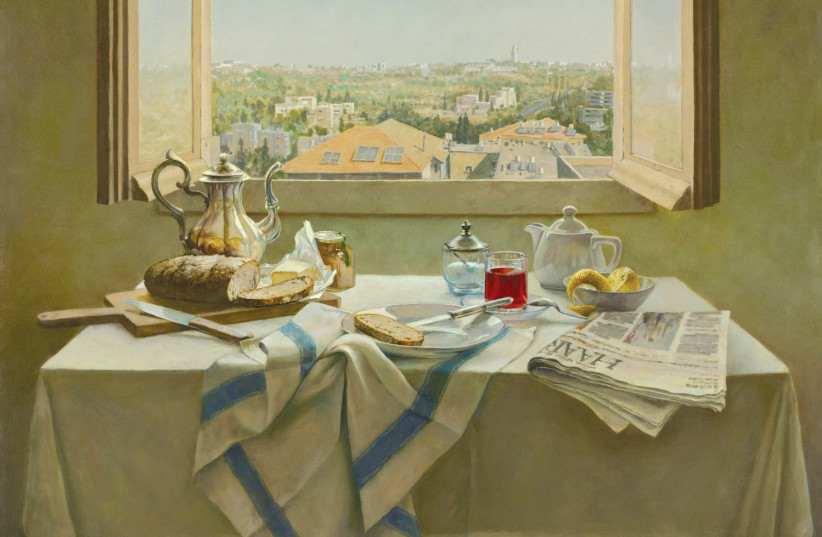Marek Yanai had a dance student who told him that from the balcony of her apartment, he could see a spectacular view from Emek Hamatzleva, the Valley of the Cross in Jerusalem named after the Monastery of the Cross, all the way to the Knesset.
The dancer’s family were olim, new immigrants to Israel from Paris, and the artist was impressed by the way they kept the life of Parisians in Israel. When the family went on vacation to France, they gave Marek a key to paint an intimate scene of transplanted European splendor. This is how Yanai’s masterpiece ‘Breakfast in Talbiya’ was born.
A major exhibition at Beit Avi Chai Gallery, Marek Yanai: On the Threshold, focuses on Yanai’s richly expressive landscape paintings and portraits and are on display until the end of July. Inside Beit Avi Chai, a modern jewel of a cultural center containing a gallery, library, theater and more on King George Avenue, the artist beckons us back to wander through an older, more rustic Jerusalem, the city he has called home for more than 50 years. Yanai invites us into courtyards, stairwells and to become intimately acquainted with portraits of Israeli cultural leaders, tastemakers, friends and teachers whom he’s known over his lifetime.
“Marek’s works affect people emotionally, and even those who thought they knew everything about the city, leave with a new perspective and learn new ways of experiencing Jerusalem,” said the exhibition’s curator, Amichai Chasson, the well-known poet, podcaster and filmmaker.
While ‘Breakfast in Talbiya’ is, for me, the exhibition showstopper, offering a romantic glimpse of an upper-class Parisian’s morning routine, complete with Haaretz newspaper, another painting shown alongside, called ‘Breakfast in Katamon,’ is closer to the artist’s daily reality. Here he paints presumably his ideal breakfast – a simple plastic milk pitcher, a cereal bowl, and a repurposed jar filled with water and a branch of flowering blossoms.

At Beit Avi Chai Gallery, we are left in silence standing before Yanai’s paintings to form our associations. A blue and white dish towel crumpled on the dining table may look like the Israeli flag. Yanai leaves it up to the viewer to interpret whatever they see fit.
“I live with simple things around me, middle-class Israeli, everyday mundane objects. I paint everyday life, the stuff everyone needs during the day but they don’t stop to look at it,” Yanai explained.
That blue and white dish towel works on the psyche.
<br>Born in a Displaced Persons Camp
Yanai was born in 1946 in Mannheim, Germany, in a displaced person’s camp, and grew up in postwar Poland, where his parents, had established themselves as successful photojournalists. The family, concentration camp survivors, chose to return to Lodz, where he was raised until he was 11. They all became new olim in order to reunite with the remaining survivors of his family already in Israel.
After military service, he studied at the Bezalel Academy of Art and Design with Josef Hirsh, the great Israeli master of drawing. Since the age of 20, he’s made Jerusalem home.
But life as an art student at Bezalel wasn’t easy despite Yanai’s prodigious talents. Early in the 1970s, Bezalel had a certain artistic tradition that went against the grain of the young artist’s thinking; teachers told him this wasn’t the place for him. Eventually, they changed their mind and according to his lifelong friend, “he prevailed and became one of the most popular teachers at Bezalel Academy of Art and Design.”
<br>Long Overdue Recognition
As part of a young community of Israeli poets, a talented movie director and a graduate of the Sam Spiegel School of Film, Amichai Chasson saw Yanai as a hidden treasure and reached out to the artist.
“Due to his modesty, Yanai has not received the recognition that an artist of his status deserves. What interests me is the layer of depth beneath the surface of his art, the layers that go beyond the obvious and tell a hidden story,” Chasson added, noting that this is the reason that he chose to include poetry alongside Yanai’s exhibited artworks, to remind viewers about the depth that lies beneath the surface.

An Exhibition Overflowing to the Second Floor
Beit Avi Chai approached the exhibition by presenting a selection of Yanai’s oil paintings on the first floor. On the second floor, a separate gallery showing Yanai’s oversized watercolor portraits of well-known Israeli art and literary treasures are hung, alongside screens with film interviews that show the way in which Yanai paints in his studio. A long sunlit hall is filled with watercolor scenes of Jerusalem that are grand in scale, yet intimate in feeling and full of surprises.
Dr. David Rozenson, executive director of Beit Avichai, echoes Chasson’s sentiments by noting: “He doesn’t hide things. You can see the paintings of Jerusalem are very real. You’ll see the water towers on top of buildings. You’ll see the plastic containers with bags of milk. And yet, in every painting, light pours through. He mixes the mundane with the light of the divine.”
“In this exhibition, I heard so many interesting things about my painting that I didn’t think were there,” Yanai laughs in response to hearing reactions to his art. “I’d rather hear what others are saying about my paintings than to explain them myself.”
Yanai has been reminded many times that his paintings bear a striking resemblance to the 17th-century Dutch still-life painters when artists created with a strong awareness of their own mortality and that of their clients. A great admirer of the Dutch Old Masters, Yanai was impressed by how the old master painters showed the passage of time, subtly, in a clock, a candle, and with a worm-eaten flute.
From his spacious sunny studio in Talpiot, well organized with paintings spanning more than 50 years, Yanai will also emphasize the differences.
“Most of the Dutch old master paintings were commissioned, and there was a fashion these painters followed. People thought paintings had to refer to the idea of wealth or status not being forever. Showing all this richness was also part of saying it’s impermanent. Once you get a commission you are obliged to satisfy the client and then you work for the client. You don’t work for the painting,” Yanai explains.
We’re sitting in his airy morning-sunshine-filled studio in Talpiot, two folding chairs facing each other, the artist’s hands rising and falling over a black T-shirt and blue jeans as he explains why he doesn’t do commissions.
“Sometimes people ask me if I would do a commission for a portrait and I don’t. I say I’ll be happy to paint you. But it’s not a commission. Mostly they get a print of it. If it’s good enough then I want it for myself,” Yanai says in all seriousness.
A year ago, in the thick of the COVID-19 pandemic, if you had asked Yanai if there was a possibility of having a show like this at Beit Avi Chai Gallery, this hidden treasure of Jerusalem would have said no. “It wasn’t realistic. It was just dreaming, because I couldn’t imagine a place like Beit Avi Chai finding interest in my paintings and certainly not investing that much talent, exhibition space and goodwill at the level it came up.”
Yanai’s humility is as fresh and welcoming as the clear skies he paints. In truth, he’s been a fixture on the Jerusalem gallery scene for decades, exhibiting his paintings since 1974 in solo exhibitions in cities as far-flung as Vienna, New York and Philadelphia, and a senior instructor at Bezalel since the mid-1990s.
“I’m not talking about the works. I’m talking about the attitude of Beit Avi Chai Gallery. With my exhibition, something happened with their willingness to make it outstanding. It’s the first time for them to make it an exhibition on two floors. They made close to 10 billboards around Jerusalem from paintings I’ve done. Beit Avi Chai chose the spots near the paintings, such as Moon Grove in the Greek Colony. There was an advertisement close to the Jerusalem Cinematheque where you can see the Old City from above, and the painting they put there was of the same scene from another angle. Another painting of the Valley of the Cross, the Knesset and the monastery, they made into a billboard and put next to the monastery,” Yanai said with genuine surprise.
“I think I was lucky that my show came exactly at this time, the end of Corona, the end of the buildings being closed for nearly two years, and advertising makes people become aware again of Beit Avi Chai. I was lucky to be the instrument,” Yanai said.
And oh, what an instrument. The Jerusalem we all know, orchestrated by sirens, alarms, barking dogs, meowing cats, honking horns, cantankerous neighbors and construction sites’ relentless drilling, turns silent in the hands of watercolor and oil painter, Marek Yanai. It feels like a great novelty to stand in front of familiar scenes of ordinary Jerusalem life, without the cacophony. Doing so, we see more than meets the eyes of this extraordinary artist.
Founded in 2007, and housed in a beautiful modern building in the heart of Jerusalem, Beit Avi Chai’s mission is to celebrate Israeli culture and Jewish identity with programs that run throughout the year. The name Beit Avi Chai refers to the biblical story of Joseph, as he emotionally reunites with his brothers and asks – Ha’od Avi Chai?, Is my father still alive? Joseph shows his genuine love for the Jewish people and a Jewish future. ❖
The On the Threshold exhibition of Marek Yanai’s art continues at Beit Avi Chai until the end of July. For more information call: (02) 621-5300.
The writer is an artist and the author of the memoir, The Wagamama Bride: A Jewish Family Saga Made in Japan.
